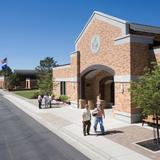- Red Lake Nation College is a public tribal land-grant community college on the Red Lake Indian Reservation in Red Lake, Minnesota. It is fully accredited by the Higher Learning Commission and enrolls about 150 students.
School Highlights
Red Lake Nation College serves 152 students (57% of students are full-time).
Minority enrollment is 65% of the student body (majority Black), which is more than the state average of 42%.
Quick Facts (2025-26)
- Enrollment: 152 students
- Minority enrollment: 65%
- Source: Integrated Postsecondary Education Data System (IPEDS)
Top Rankings
Red Lake Nation College ranks among the top 20% of public schools in Minnesota for:
Category
Attribute
School Resources
School Overview
Red Lake Nation College
(MN) Community College Avg.
Carnegie Classification
Not applicable, not in Carnegie universe (not accredited or nondegree-granting)
Associate's Colleges: Mixed Transfer/Career & Technical-Mixed Traditional/Nontraditional
Institution Level
At least 2 but less than 4 years
At least 2 but less than 4 years
Institution Control
Public
Public
Total Faculty
n/a
171 staff
School Calendar
Student Body
The student population of Red Lake Nation College has stayed relatively flat over five years.
The Red Lake Nation College diversity score of 0.69 is more than the state average of 0.63. The school's diversity has stayed relatively flat over five years.
Total Enrollment
152 students
2,858 students
Student-Teacher Ratio
n/a
22:1
# Full-Time Students
86 students
1,050 students
# Part-Time Students
66 students
1,808 students
# Enrollment Undergraduate
n/a
420 students
# Full-Time Undergraduate Students
86 students
915 students
# Full-Time Graduate Students
n/a
38 students
# Part-Time Undergraduate Students
66 students
1,771 students
# Part-Time Graduate Students
n/a
12 students
Total Dormitory Capacity
n/a
116 students
% American Indian/Alaskan
n/a
1%
% Asian
n/a
6%
% Hispanic
6%
8%
% Black
41%
15%
% White
35%
58%
% Hawaiian
12%
1%
% Two or more races
6%
4%
% Non Resident races
n/a
1%
% Unknown races
n/a
6%
Diversity Score
0.69
0.63
College Completion Rate (Students who graduate in less than 4 years)
23%
34%
College Completion Rate (Students who graduate in 4 years or more than 4 years)
n/a
57%
Tuition and Acceptance Rate
% Students Receiving Some Financial Aid
100%
89%
Median Debt for Graduates
n/a
$12,264
Median Debt for Dropouts
n/a
$6,750
Acceptance Rate
n/a
94%
SAT Reading
n/a
625
SAT Math
n/a
600
SAT Writing
n/a
565
ACT Composite
n/a
24
ACT English
n/a
24
ACT Math
n/a
23
ACT Writing
n/a
8
Source: 2024 (or latest year available) Integrated Postsecondary Education Data System (IPEDS) , School Administrators
Frequently Asked Questions
What is Red Lake Nation College's ranking?
Red Lake Nation College ranks among the top 20% of community college in Minnesota for: Percent of students receiving financial aid.
Recent Articles

Scholarships for Community College Students 2025
Explore updated scholarship programs, tuition data, and expert strategies for community college students in 2025.

The Rise of Technical and Vocational Training in 2025
Explore the 2025 surge in technical and vocational training—enrollment, policy, costs, and why this path is gaining ground for students and parents.

Stackable Credentials: How Community Colleges Advance Careers
Discover how community colleges use stackable credentials to build career pathways, boost earnings, and enable lifelong learning in 2025.











